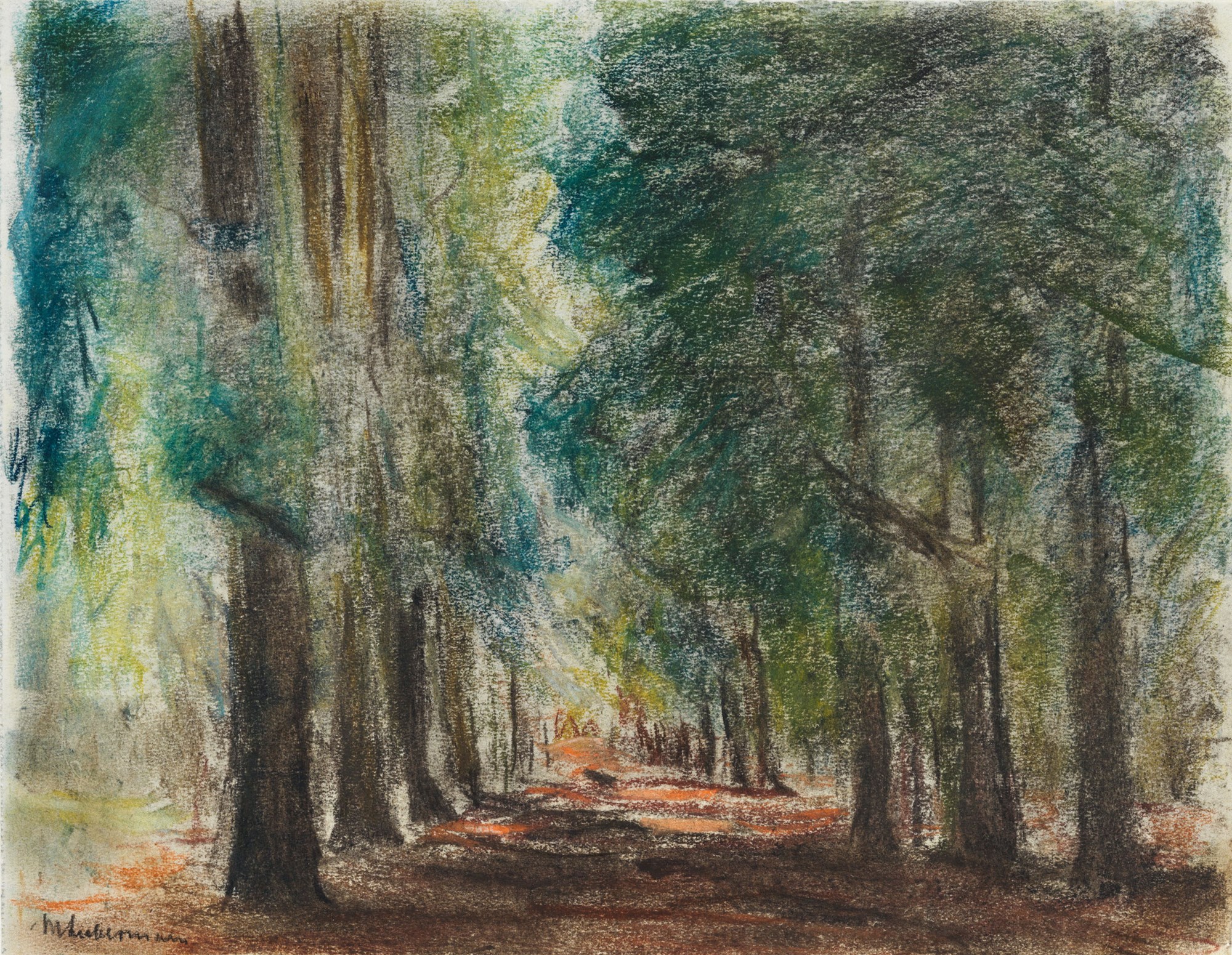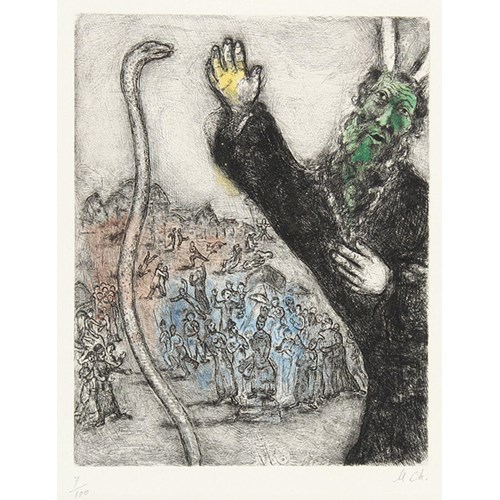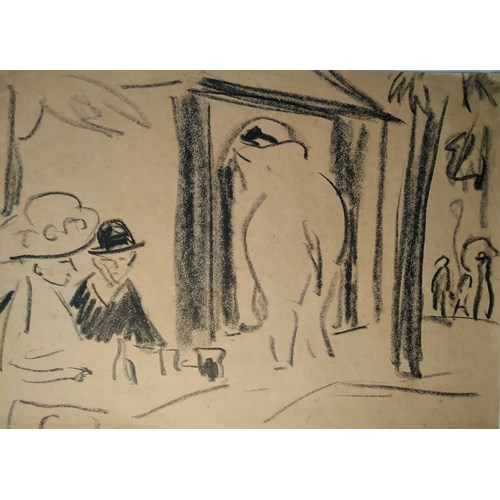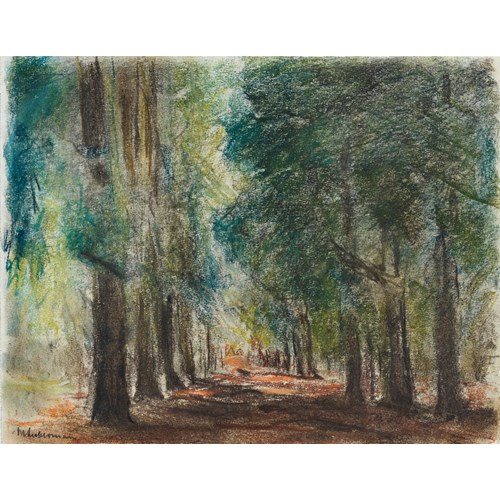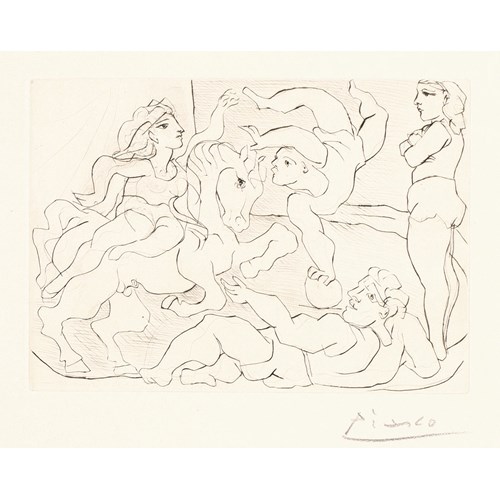Marketplace
Allee in Sacrow
Max Liebermann
Allee in Sacrow
Date 1924
Period 20th century
Dimension 23.2 x 29.7 cm (9¹/₈ x 11³/₄ inches)
Framed dimension cm (15³/₄ x 19⁵/₈ x 1¹/₈ inches)
The chalk and pastel studies represent expressive variations on the oil-painted versions of the motif. In contrast to these, Liebermann dispenses with the depiction of the two riders in the pastels, and thus with an anecdotal moment. Instead, as in our work, he concentrates entirely on the depiction of his impression of nature: in the daring detail of the picture, the view opens up directly onto the alleyway with its towering trees, whose perspective is foreshortened in the distance. Their dense green foliage forms a body through which the yellow rays of sunlight make their way here and there, leaving colourful reflections on the ground. In this impression of a quiet moment, Liebermann captures the atmospheric effect in an extremely subtle way and reproduces the depth and transparency of the space beneath the massive treetops. In doing so, he pushes back the depiction of details in favour of the overall effect - everything is filled with shimmering sunlight, even more, the picture is painted light. This is to be taken almost literally, as Liebermann applies the densely placed chalk strokes with virtuosity; he ‘interweaves’ them in such a way that forms and curves, which one might subordinate to the composition, are joined together in an almost abstract manner. Light, shadow, reflections and colourful atmosphere - these are the elements that the artist poetically interweaves. And he succeeds in intensifying the expression of this lyrical contemplation of nature to such an extent that one would think one could hear the whirring of the light. Liebermann also heightens the motif to a sublime, almost sacred quality. The high tree arcades, the vaulted canopy and the deep alignment of the path are reminiscent of the overwhelming halls of Gothic cathedrals. No human figure indicates proportions here, so that the dimensions of the ‘shadow hall’ are not comprehensible. Unlike his avenue views with walkers, riders, carriages and cars, Liebermann is not depicting a Sunday idleness here. What he puts on paper is his very personal encounter with nature, and he does this out of a need to expressively emphasise the wonderful.
The artist captures the light and carefree mood in his wonderfully impressionistic style. The theme of the avenue is one of the artist's favourite subjects, which he returns to again and again in his work. It is ideal for the application of his style, in which he succeeds in creating an effective depth of space through the alignment of the avenue in combination with his individual Impressionism.
Max Liebermann painted ‘Allee in Sacrow’ in 1924. The avenue occupies a special position as a motif in Liebermann's landscape paintings. Hardly any other artist at the beginning of the 20th century turned to this theme with such vigour. In his later years, Liebermann captured the avenue in Sakrow near Potsdam in particular in several pastels, charcoal drawings and paintings. In this exemplary work from his mature creative phase, Liebermann condensed light, shadow, light reflections and the colourful atmosphere into a vibrant composition and heightened the motif of the avenue to a sublime, almost sacred quality. In their arrangement and imposing height, the trees are sometimes reminiscent of the walls of Gothic cathedrals. Only here and there do the dense treetops allow the sun's rays to shine through. Supported by the lush greenery, the avenue, which is aligned in perspective, lends depth to the painting.
Sacrow Palace Park is now the northernmost point of the Berlin-Potsdam cultural landscape. Sacrow Palace, including the park, was built in 1773 as a baroque manor house and became the property of King Frederick William IV in 1840. After his accession to the throne, he commissioned Peter Joseph Lenné (1789-1866) to remodel the grounds and extend them to the north. Today, Sacrow Palace Park covers 26 hectares. Liebermann's enthusiasm for park and forest paths, which had already been kindled in his early years, was to continue in his mature work. When the artist retired to his country estate on Wannsee in later years, he concentrated primarily on portrait painting and the depiction of garden views, but could not escape the magic of the avenues and park views surrounding his retreat. The avenues of the Tiergarten and, above all, his garden, inspired him to create ever new pictorial variations. However, the avenue in Sakrow is undoubtedly one of his favourite motifs.
Date: 1924
Period: 20th century
Signature:
Signed on the lower left.
EXPERTISE: We thank Drs Margreet Nouwen for kindly confirming the authenticity
Dimension: 23.2 x 29.7 cm (9¹/₈ x 11³/₄ inches)
Provenance: Leicester Galleries, London (-1934); private collection Great Britain (1934-2022 in succession)
More artworks from the Gallery


